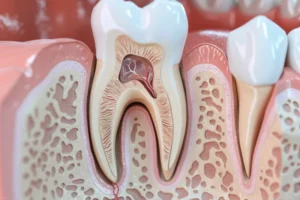A periapical abscess is a type of dental infection that occurs at the root tip of a tooth or in the surrounding bone tissue. This condition is often caused by untreated dental cavities, trauma to the tooth, or prior dental work that becomes compromised. It manifests as a painful, pus-filled swelling that can lead to severe discomfort and may spread if not treated promptly. Understanding the symptoms and seeking timely dental care is crucial to manage the pain and prevent further complications such as the spread of infection to other parts of the body.
What is a Periapical Abscess?
A periapical abscess is a localized collection of pus that occurs at the tip of the root of a tooth, usually resulting from a bacterial infection. This type of abscess can cause intense pain and, if left untreated, may lead to severe complications. In dental health, recognizing and treating a periapical abscess in its early stages is crucial to prevent the spread of the infection and to preserve oral function.
The development of a periapical abscess can be a slow process, often starting with a minor infection before escalating into a more serious condition. Understanding the underlying causes and symptoms of periapical abscesses can help in early diagnosis and effective treatment. As we delve into the specifics, we will first discuss the definition and causes of this dental issue.
Definition and Causes
A periapical abscess, also known as a dental abscess, forms at the apex of an infected tooth root. The primary cause is typically an untreated dental cavity, cracked tooth, or trauma, which allows bacteria to penetrate deep into the tooth pulp. Once inside, the bacteria multiply, leading to the formation of pus, a thick fluid composed of dead tissue, bacteria, and immune cells.
Several factors can contribute to the development of a periapical abscess:
- Dental caries (cavities): The most common cause, as caries can erode the enamel and dentin, providing a pathway for bacteria to reach the pulp.
- Trauma: Physical injury to a tooth can crack or break it, giving bacteria a direct route to the pulp.
- Periodontal disease: Severe gum disease can affect the surrounding tissues and bone, leading to abscess formation.
- Previous dental work: Improperly sealed dental restorations can also become a source of infection.
Common Symptoms
Recognizing the symptoms of a periapical abscess is important for timely intervention. The most prominent symptom is severe, throbbing toothache that can radiate to the jaw, neck, or ear. This pain is caused by the pressure of the pus buildup within the confined space of the tooth.
Other common symptoms include:
- Swelling: The affected area may swell, and in severe cases, facial swelling can occur.
- Sensitivity: The tooth may become highly sensitive to hot and cold temperatures.
- Fever: An infection can cause systemic symptoms such as fever and general malaise.
- Bad breath and taste: The presence of pus can lead to a foul taste in the mouth and bad breath.
In some cases, the abscess may rupture, leading to the sudden release of foul-smelling and foul-tasting fluid in the mouth. This can temporarily relieve pain but does not mean the infection has healed. Immediate dental care is essential to treat the underlying infection and prevent further complications.
Understanding what a periapical abscess is, along with its causes and symptoms, can be instrumental in early detection and treatment. If you found this article helpful, consider reading our other articles on dental health and the various treatments available for different oral conditions. By staying informed, you can maintain a healthier smile and overall well-being.
Diagnosis and Treatment of Periapical Abscess
A periapical abscess is a pocket of pus at the tip of a tooth’s root, often due to an untreated dental cavity, an injury, or prior dental work. Understanding the diagnosis and treatment of periapical abscesses is crucial for both patients and dental professionals. Proper diagnosis and timely treatment can prevent severe complications and promote oral health.
Accurate diagnosis involves a combination of clinical examination and imaging techniques. Treatment options range from conservative management to surgical intervention, depending on the severity of the infection. Let’s delve into the different diagnostic methods and treatment options available for managing periapical abscesses.
Diagnostic Methods
Effective diagnosis of a periapical abscess involves both clinical evaluation and radiographic assessment. Clinicians typically start with a thorough oral examination, checking for signs of infection such as swelling, tenderness, and tooth mobility. Patients may also report symptoms like severe toothache, fever, and foul taste, which can aid in diagnosis.
Radiographic imaging, specifically periapical radiographs (X-rays), is a critical tool in diagnosing periapical abscesses. These images allow dentists to visualize the bone and root structure, revealing the extent of the infection. More advanced imaging techniques, such as Cone Beam Computed Tomography (CBCT), provide three-dimensional views, offering a more detailed understanding of the abscess and surrounding tissues.
In addition to imaging, clinicians may perform pulp vitality tests to assess the health of the tooth’s nerve and blood supply. These tests help differentiate between reversible pulpitis and irreversible pulpitis or necrosis, guiding the appropriate treatment plan.
Treatment Options
The primary goal in treating a periapical abscess is to eliminate the infection and save the tooth if possible. Treatment options may vary based on the severity of the abscess and the patient’s overall health. Common treatment approaches include:
- Drainage of the Abscess: Draining the pus from the abscess is often the first step. This can be achieved through an incision in the gum or by creating an opening in the tooth.
- Root Canal Therapy: This involves removing the infected pulp tissue, cleaning the root canals, and sealing them to prevent further infection. Root canal therapy is an effective way to save an abscessed tooth.
- Extraction: In cases where the tooth cannot be saved, extraction may be necessary to prevent the spread of infection.
- Antibiotics: Antibiotics may be prescribed to control the infection, especially if it has spread beyond the tooth into surrounding tissues.
Post-treatment care is essential for ensuring proper healing and preventing recurrence. Patients are advised to maintain good oral hygiene, follow-up with their dentist regularly, and avoid habits that could compromise their oral health, such as smoking. In conclusion, timely and accurate diagnosis, coupled with appropriate treatment, is vital for managing periapical abscesses effectively. By doing so, we can preserve the patient’s oral health and prevent potential complications. For more insights into dental health and advanced treatment options, explore our other articles.
Preventing Periapical Abscess
A periapical abscess, a collection of pus caused by an infection at the tooth’s root, can lead to severe pain and other complications if left untreated. Preventing this dental issue is crucial for maintaining overall oral health. There are several proactive steps individuals can take to avoid the development of a periapical abscess. This article explores some effective preventative measures.
Adopting good oral hygiene practices and scheduling regular dental check-ups play a significant role in preventing periapical abscesses. By implementing these preventive strategies, you can reduce the risk of infections and ensure the longevity of your dental health.
Good Oral Hygiene Practices
Maintaining good oral hygiene is foundational to preventing infections that may lead to a periapical abscess. Brushing teeth at least twice a day with fluoride toothpaste helps remove plaque, a sticky film of bacteria that can cause tooth decay and gum disease. It is equally important to floss daily to eliminate food particles and bacteria from between the teeth and along the gumline, areas that a toothbrush might miss.
In addition to brushing and flossing, using an antiseptic mouthwash can help reduce bacteria levels in the mouth, further preventing dental infections. Such mouth rinses can reach areas that brushing and flossing might overlook, providing an extra layer of protection against harmful bacteria.
Diet also plays a critical role. Limiting the intake of sugary and acidic foods reduces the risk of tooth decay, which can progress to more serious infections if not managed properly. Regular consumption of a balanced diet rich in vitamins and minerals supports overall oral health.
Regular Dental Check-Ups
Regular dental check-ups are essential in the early detection and prevention of periapical abscesses. Dentists can identify signs of tooth decay, gum disease, or other oral health issues before they develop into more significant problems. Early intervention can prevent minor issues from escalating into infections that lead to abscesses.
During these appointments, professional cleanings remove plaque and tartar build-up that regular brushing and flossing might miss. Dental professionals also provide advice tailored to your specific oral health needs, helping you maintain optimal dental hygiene practices at home. Moreover, x-rays taken during dental check-ups can reveal hidden problems, such as abscesses or bone loss, that are not visible during a standard oral examination. This comprehensive approach ensures that any potential issues are promptly addressed, significantly reducing the risk of developing a periapical abscess.
By incorporating these practices into your routine, you can protect your teeth and gums from infections and other complications. For more detailed information on oral health and preventative care, consider exploring additional articles and resources.
Frequently Asked Questions about Periapical Abscess
If you’re seeking more clarity on periapical abscesses, here are some common questions and answers to help you understand this dental condition better.
What causes a periapical abscess?
A periapical abscess is usually caused by an untreated dental cavity, injury, or prior dental work that leads to infection. Bacteria can invade the dental pulp – the innermost part of the tooth that contains blood vessels, nerves, and connective tissue – and result in an infection that spreads to the root of the tooth. This condition can lead to the formation of pus and, if left untreated, can damage surrounding tissues and bone.
How is a periapical abscess treated?
Treatment for a periapical abscess aims to eliminate the infection and promote healing of the affected tooth. Options typically include antibiotics to fight the infection, a root canal to remove the infected dental pulp, or extraction of the tooth if it’s severely damaged. Additionally, a dentist might perform incision and drainage to remove the pus. It’s essential to follow up with proper dental care and hygiene to prevent future occurrences.

My name is Salman Kapa, a 73-year-old expert in bone regeneration and dental implantology. With decades of experience in the field, I am dedicated to advancing our understanding of oral health and hygiene. Through my research and writing, I aim to contribute to the development of innovative solutions in dental care.




